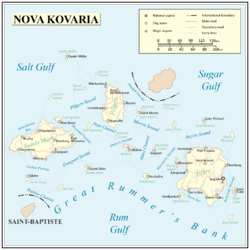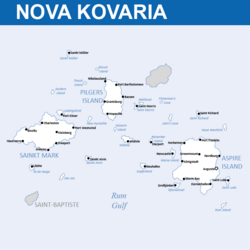Nova Kovaria
This article is incomplete because it is pending further input from participants, or it is a work-in-progress by one author. Please comment on this article's talk page to share your input, comments and questions. Note: To contribute to this article, you may need to seek help from the author(s) of this page. |
Republic of Nova Kovaria Republik Niuwekovår (Tyrnican) | |
|---|---|
| Motto: "Quaerere novos prospectus" "Seek new horizons" | |
 Atlas of Nova Kovaria | |
 Map of Nova Kovaria | |
| Capital and largest city | Augusta |
| Official languages | Rythenean, Tyrnican |
| Recognised national languages | Principean |
| Recognised regional languages | Baptistois Creole |
| Demonym(s) | Nova Kovarian or Kovarian |
| Government | Unitary parliamentary republic |
| Jonas Granger | |
| Laura Pastor | |
| Legislature | Parliament |
| Assembly | |
| Senate | |
| Establishment | |
• Governorship of Nova Kovaria | 9 May 1799 |
• First Nova Kovarian Republic | 30 September 1868 |
• August Revolution | 10 June 1921 |
| Area | |
• Total | 18,778.46 km2 (7,250.40 sq mi) |
• Water (%) | negligeble |
| Population | |
• 2020 census | 6,756,433 |
• Density | 359.79/km2 (931.9/sq mi) |
| GDP (PPP) | 2020 estimate |
• Total | $313.059 billion |
• Per capita | $46,338 |
| GDP (nominal) | 2020 estimate |
• Total | $331.226 billion |
• Per capita | $49,027 |
| Gini (2020) | medium |
| HDI (2020) | very high |
| Currency | Nova Kovarian Note (₦) (NKN) |
| Date format | dd-mm-yyyy |
| Driving side | left |
| Calling code | +19 |
| ISO 3166 code | NKV |
| Internet TLD | .nk |
Nova Koravia (Tyrnican: Niuwekovår), officially the Republic of Nova Kovaria (Tyrnican: Republik Niuwekovår) is an island country located in the Rum Gulf. Its closest neighbor is Saint-Baptiste, with whom it shares the Rum Islands archipelago. It has a population of 6,756,433 people spread across 3 major and numerous minor islands. Its capital and largest city is Augusta on Aspire Island.
Home to native peoples since at least the 1st century, Tyrnican and Rythenean settlers arrived in the early-mid 17th century, haphazardly establishing settlements on the archipelago. Slavery in the form of chattel slaves (from Idica) and indentured servants (from Auressia and, to a lesser extent, Surucia) arrived soon after. These institutions would result in a boom of cash crop and monocultural plantation farming, including sugar, coffee, and fruits. Cooperation emerged between the Tyrnican and Rythene populations, forming a distinct Nova Koravian identity. During the Tyrno-Rythenean Wars, the Rythenean controlled islands were taken and the archipelago was reorganized under the single Governor of Nova Kovaria. Tyrnican rule would last until 1854 when the islands were traded to Audonia for a long-term partnership. Turmoil in Aurdonia and unrest in the islands, however, would lead to independence in 1868 as the First Republic of Nova Kovaria. This republic would eventually fall to a coup in the late 1880’s before being restored during the August Revolution in 1922.
Nova Kovaria is a developed nation and has a broad manufacturing sector, including high-tech, petrochemical, pharmaceutical, and industrial machinery industries. It also retains robust financial and service sectors, as well as an emerging spaceflight industry. Tourism is also a large industry, though it is highly localized and often not the focus of the nation. For the most part, agriculture has been superseded by manufacturing, and much of the islands’ food is imported. A lack of other natural resources has created a deficit to import the raw materials and basic goods needed for Nova Kovaria’s manufacturing. Fossil fuels, especially, are a significant portion of its international trade.
Etymology
The name "Nova Kovaria" is a Latinization of "New Kovaar", and is the recognized Rythenean-language name for the nation. In Tyrnican the name is "Niuwekovår" which is a direct translation of "New Kovaar". The nation's name originally came from the charter establishing the Governorship of Nova Kovaria, which named the colony after old Kovaar in Tyrnica.
Economy
Nova Kovaria has a highly developed market economy primarily centered around manufacturing, services, and high-tech industry. Kovarian brands and companies, such as XXXX and XXXX, have become world reknown for their high quality goods. The nation is at the forefront of the growing commercial spaceflight industry, with both public and private organizations investing in the sector.
Kovarian investment into science and technology has given it international reknown for its software, communication, engineering, and other areas of research.
The currency of Nova Kovaria is the Nova Kovarian Note (NKN or ₦), which is issued by the Central Kovarian Reserve Authority (CKRA).

